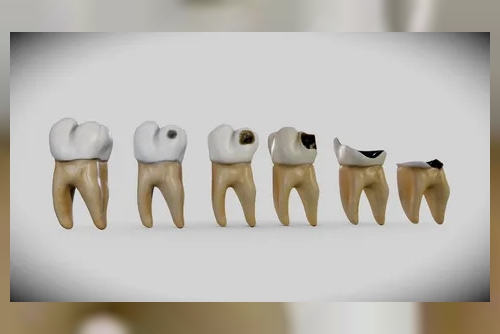Causes
of Tooth Decay
Tooth decay, also known as dental caries, is caused by acids produced by
bacteria in the mouth. When you consume foods or drinks containing sugar and
starches, the bacteria that naturally live in your mouth use them to produce
acids. Over time, these acids dissolve and damage tooth enamel, leading to
cavities. The main bacteria responsible for tooth decay are Streptococcus
mutans and Lactobacillus. They thrive on sugar and starches found in foods like
candy, cookies, soda, fruit juices, dried fruit, chips and starchy vegetables.
Frequent snacking and sippping sugary drinks throughout the day increases the
risk of cavities as it provides a continuous supply of food for the bacteria.
Saliva helps neutralize the acids and rinse food particles out of your mouth,
but it may not be enough when sugar intake is excessive or very frequent.
Diagnosis and Dental Caries Treatment
Options
If you notice white or brown spots on your teeth or are experiencing tooth
sensitivity, it's a good idea to visit your dentist for an examination. Your
dentist will look for signs of decay using intraoral cameras, dental mirrors
and probes. They may also take X-rays to detect cavities below the enamel surface
that can't be seen visually. Once tooth decay is confirmed, your dentist will
discuss treatment options based on the extent of damage. For minor cavities
that have just started penetrating the outer enamel layer, your dentist may
recommend preventive treatments like fluoride therapy or remineralizing therapy
to halt or reverse the decay process. For deeper cavities that have reached the
inner layers of the tooth, dental fillings are usually necessary. Other
treatment options include dental crowns, root canals, or tooth extractions in
severe cases of decay.
Dental Fillings
Dental fillings are the most common Dental
Caries Treatment for cavities affecting the inner layers of the tooth.
During a filling procedure, your dentist will first numb the tooth using local
anesthesia. They will then carefully remove any decayed portion of the tooth
using small drills, burrs or lasers. Next, they will clean and reshape the
cavity before filling it. Common filling materials used include amalgam,
composite resin and glass ionomers. Amalgams contain mercury, silver, tin and
other metals. They have been used for over 150 years but some people have
concerns over mercury exposure. Composite resins closely match the color of
natural tooth structure and rarely cause allergic reactions but may wear down
faster over time. Glass ionomers bond chemically to tooth structure and slowly
release fluoride but are more likely to stain. Your dentist will recommend the
ideal material based on the location and size of the cavity. After placing the
filling material, it is polished and contoured to restore the tooth to its
original shape. Fillings generally last several years but may need replacement
over time if the tooth undergoes more decay.
Dental Crowns
Dental crowns, also known as caps, are recommended when a large portion of the
tooth structure is damaged due to decay or injury. During a crown procedure,
your tooth is first prepared by carefully shaving down the damaged area to
allow for the crown. An impression is then taken and sent to a dental lab,
where a crown made of porcelain or other materials will be fabricated to
precisely fit over the prepared tooth. When the crown arrives back at the
dental office after 1-2 weeks, it is carefully placed over the tooth and
permanently cemented into place. Crowns strengthen and protect the remaining
tooth structure. They can restore a damaged tooth to its original shape, size,
alignment and function. Crowns are commonly used to cover dental fillings,
implants, or to increase the strength of teeth that have undergone root canals.
They typically last 10-15 years with proper care.
Root Canals for Dental Caries Treatment
When a dental cavity penetrates deep inside the tooth and infects the dental
pulp inside the root canal system, a root canal treatment may be needed to save
the tooth. During a root canal procedure, your dentist will anesthetize the
tooth and make a small opening through the chewing surface to gain access to
the infected pulp. They will then gently remove all diseased pulp tissue from
the narrow root canals using specialized endodontic instruments like files,
broaches and irrigants. The canals are then carefully cleaned, shaped and
sealed with gutta percha points and sealer materials. Finally, the tooth is
temporarily restored with a filling until a final restoration like a crown can
be placed. Root canals aim to retain teeth that would otherwise need extraction
by eliminating the source of infection and inflammation. Post treatment, the
tooth remains intact, supported and functioning. Success rates for root canals
are over 90% when performed by a specialist endodontist.
Tooth Extractions
Teeth that are fractured, severely decayed or lost extensive tooth structure
may need to be extracted if the damage cannot be restored. During a tooth
extraction, your dentist will first numb the injection site using local
anesthesia. They will then gently loosen and elevate the tooth from its socket
using dental forceps. Sometimes a surgical procedure is required for impacted
teeth that aren't fully erupted. The empty socket will be cleaned after
extraction and sutured if needed. Antibiotics may be prescribed to prevent
postoperative infection. Removing badly damaged or infected teeth helps relieve
pain and prevents bacteria from spreading to other parts of the mouth and body.
After extraction, your dentist can discuss options like dental implants,
bridges or dentures to restore function and aesthetics depending on the
location and number of teeth missing. Extractions are generally a last resort
as retaining natural teeth when possible is preferable.
Preventing Tooth Decay with Dental
Caries Treatment
The best approach is to prevent tooth decay from occurring in the first place
through proper oral hygiene and a healthy diet. Brushing at least twice daily
with fluoridated toothpaste and flossing daily removes dental plaque where
bacteria reside. Regular cleanings with your dentist every 6 months
professionally remove any remaining plaque and tartar deposits. Using an
antiseptic mouthwash and rinsing with water after meals also helps counter the
effects of acid production. Limiting consumption of sugary foods and drinks to
mealtimes only and choosing healthier snacks reduces the frequency and severity
of acid attacks on tooth enamel.
Get more insights on Dental Caries Treatment
About Author:
Ravina Pandya, Content Writer, has a strong foothold in the market research industry. She specializes in writing well-researched articles from different industries, including food and beverages, information and technology, healthcare, chemical and materials, etc. (https://www.linkedin.com/in/ravina-pandya-1a3984191)
















